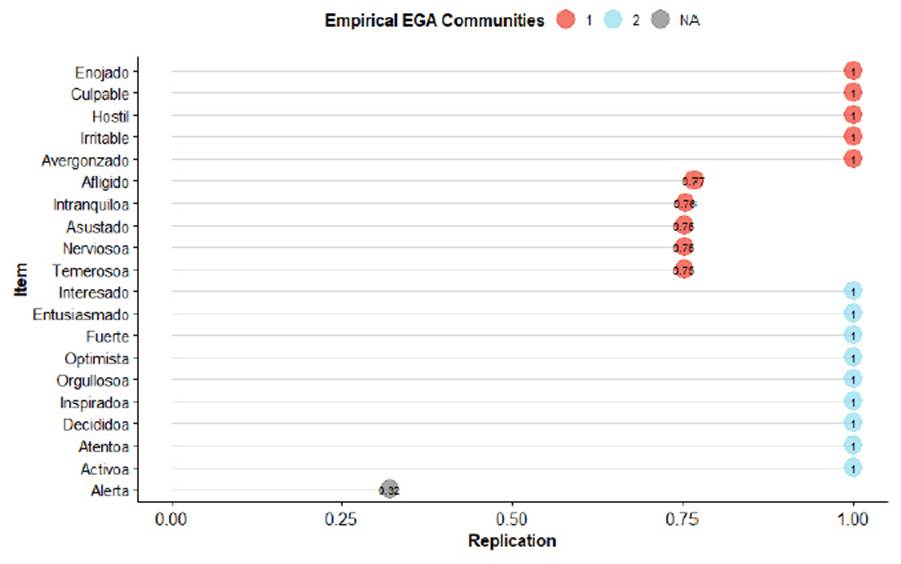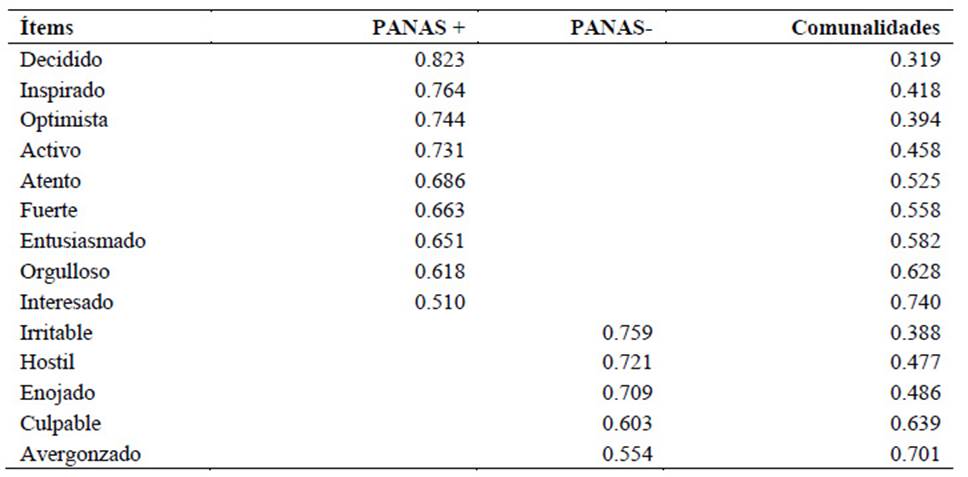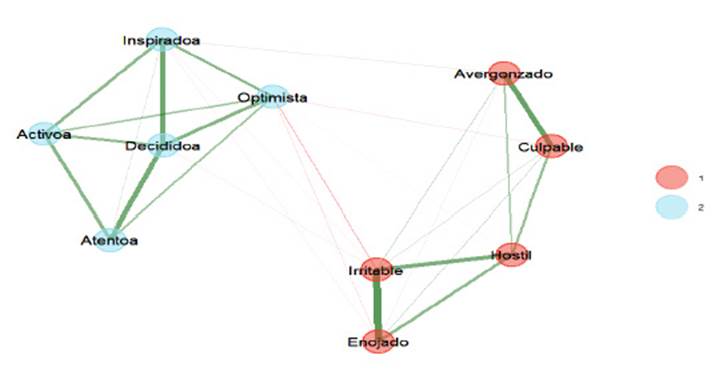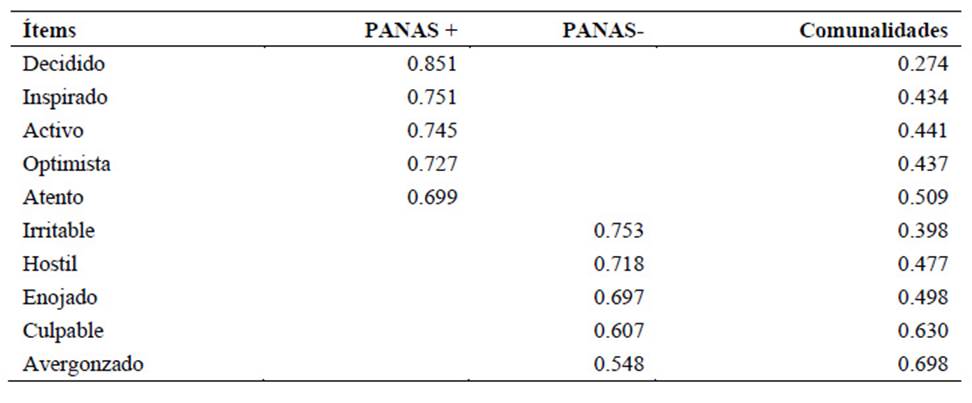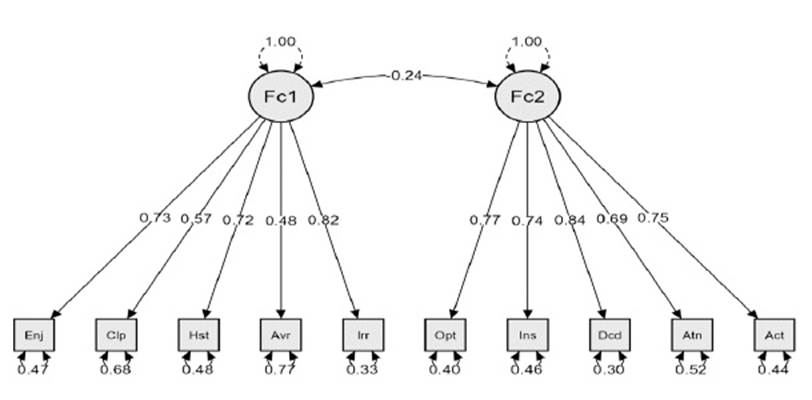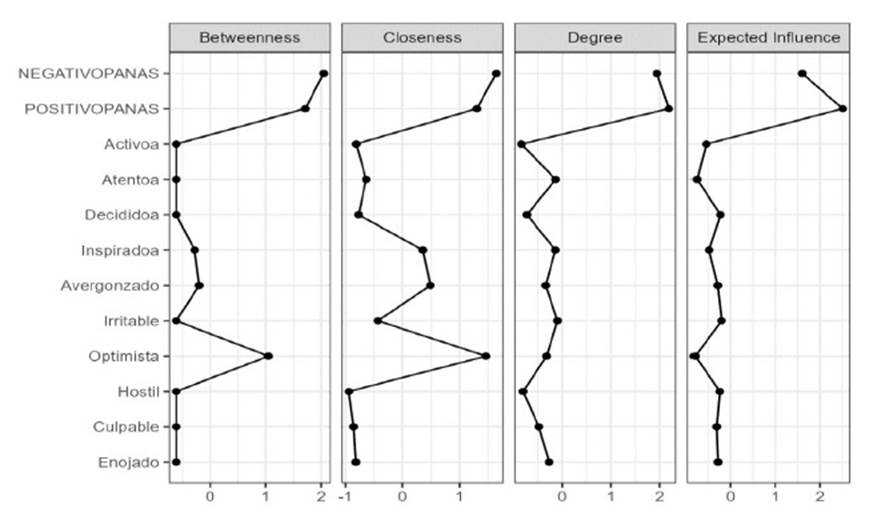Services on Demand
Journal
Article
Indicators
-
 Cited by SciELO
Cited by SciELO
Related links
-
 Similars in
SciELO
Similars in
SciELO
Share
Propósitos y Representaciones
Print version ISSN 2307-7999On-line version ISSN 2310-4635
Propós. represent. vol.11 no.1 Lima Jan./Abr. 2023 Epub Apr 30, 2023
http://dx.doi.org/10.20511/pyr2023.v11n1.1784
RESEARCH ARTICLES
Psychometric Analysis of a Reduced Version of the Scale of Positive Affect and Negative Affect in University Students of Lima
1Universidad Nacional Federico Villarreal, Lima, Perú
The objective of the study was to develop a short version of the Positive Affect and Negative Affect Scale (PANAS), based on the original version of 20 items. The sample consisted of 3960 students from a public university in Lima. The results indicate that the validity of the internal structure, through exploratory and confirmatory factor analysis, was defined by 10 items and two dimensions. Positive affects are organized into five items: determined, optimistic, inspired, active, and attentive; while negative affects are in five items: irritable, hostile, angry, guilty, and ashamed. Likewise, it was found for the final short version, standardized coefficients with factorial loads between .48 and .85, as well as the fit indices of the model were in accordance with what was expected. Internal consistency reliability indicates Alpha and Omega coefficients greater than .70 in both factors. It is concluded that the instrument presents evidence of internal structure and the scores are consistent.
Keywords: Reliability; Validity; Positive Affect; Negative Affect; PANAS; Psychometry
INTRODUCTION
Emotional experience is inherent to the human being (Choliz, 2005) and very complex to define (Ayala & Cardona, 2016). Emotion is understood as a basic affective process that generates physiological and psychological changes, as a response to a given stimulus, with high pleasant energy and a very personal meaning to its experience, which generates internal changes in the body to respond to daily events (Cabanac, 2002; Grimaldo, 2003; Reeve, 2010).
They are also described as psychophysiological reactions that allow an adaptive response to situations perceived as dangerous and threatening, producing cognitive evaluations of the events experienced, which in turn lead to reflex actions of the body as well as facial gestures that are interpreted by others (Piqueras et al., 2009).
Emotions respond to specific events and are characterized by their rapid and short duration. They are innate responses based on physiological reactions that generate adaptive behaviors, through which we assess the experience and prepare ourselves to act in different situations (Cole et al., 2004; Ekman,1992; Keltner & Gross, 1999). Emotions are like a kind of prompt-response localization device that elaborates and transmits meaning through experience (Cole et al., 2004).
In the field of psychological research, the study of emotions is highly useful, and although there is still no consensus among researchers on the formal definition of affect (Morán-Pallero & Felipe-Castaño, 2021), some authors call it emotional science or affective science, whose the fundamental component is affect. As a person learns to recognize and organize their emotions, their affective responses begin to be modeled on experiences (Niedenthal & Ric, 2017).
According to the above, it can be specified that affect is any experience or emotion, from pain to joy, from the simplest to the most complex impressions, and from normal to abnormal affective responses (VandenBos, 2015); it can also be mentioned that affect encompasses mood states, fixing them in a dimension of bipolar valence and differentiating them according to their level of activation (Rogaten & Moneta, 2015); on the other hand, behaviors that promote positive affect in daily life include thoughts, behaviors, and actions that allow maintaining a high level of affect (Ovejero & Velázquez, 2017). However, there are two areas that can be distinguished: positive affect, which reveals the degree of passion, activation, vigilance, and strength; and negative affect, whose discomfort results in stress, encompassing different affective responses of rejection such as displeasure, anger, fear and excitability (Watson et al., 2011; Watson & Clark, 1992; Watson et al., 1988a).
These opposite dimensions have a lower level belonging to dimensions of diverse emotional content and that, when analyzed, correspond to one of the dimensions of higher level; therefore, it empowers to perform emotional self-management in an adaptive way with life (Di Fabio & Kenny, 2016), as well as the use of creative cognition in the study (Rogaten & Moneta, 2015).
In contrast, the dimensions of positive and negative affect are stable and predictive over time (Lemos, 2020), affectivity being a complex psychogenetic process in the life of the human being, where affective bonds will be crucial factors of subjective well-being, health and daily life (Torres-Salazar et al., 2020; Zubiría, 2013). This is why it is important to assess affectivity at both the individual and the group level (Moreta-Herrera et al., 2021). Another, simpler definition points out that there is only one dimension of affectivity with two extremes, a left one where negative affects are located and a right one for positive affects; in the middle are ambiguous, undefined, or ambivalent affects in their phenomenological experience, and all these affects can have different degrees (Gray & Watson, 2007).
Although emotions help people in their development, they can also cause clinical problems and chronic diseases that require special attention (Lemos, 2020); therefore, their study is valuable because it allows a better understanding of people (Abarca-Castro et al., 2021).
Watson et al. (1988a) developed an instrument to measure affectivity, the Positive Affect and Negative Affect Scale (PANAS), consisting of 20 statements, in a sample of university students and administrative personnel. The structure included two factors: positive affect (PA) and negative affect (NA). External validity obtained direct correlations between negative affect (NA) of the PANAS and the Hopkins Symptom Checklist (HSCL) of .74 and .65, with the Beck Depression Inventory of .56 and .58, and with the State Anxiety Scale of .51.
Several studies have assessed the psychometric properties of the PANAS instrument in its full version, such as the translations into Spanish by Joiner et al. (1997), into German by Leue and Beauducel (2011); into Portuguese by Pires et al. (2013) and into Turkish by Peker et al. (2021). In Latin America, the Mexican adaptation by Robles and Páez (2003); in Argentina, Moriondo et al. (2012); in Chile, by Dufey and Fernández (2012); in Ecuador, by García and Arias (2019); and in Peru, by Grimaldo (2007), Gargurevich and Matos (2012), and Gómez and Leyton (2020).
Similarly, research assessing short versions of the Scale has been reported in several countries. Ruiz-Pérez et al. (2021) analyzed the psychometric properties of the short version I of the PANAS-R developed by Thompson (2007). The sample consisted of 729 people from Brazil, Colombia, North America and Western Europe. According to the factor analysis, the structure consisted of two dimensions, PA and NA. Reliability was determined by Cronbach's alpha coefficients ranging from 0.63 to 0.82 for PA and from 0.75 to 0.87 for NA.
Gouveia et al. (2019) analyzed the psychometric evidence of the Positive Affect and Negative Affect Scale (EAPN-10) in Brazil. Three studies were developed: the first with 296 university students whose exploratory factor analysis showed a bifactor structure - positive affectivity and negative affectivity; the second, 313 students who confirmed the bifactor structure with alphas greater than .70; the third study, 302 university students who responded to previous instruments and measures of optimism, depression, positivity, stress and anxiety. Evidence of criterion validity indicates that PAs (α = .83) were directly related to indicators of well-being, whereas ANs (α = .80) were directly related to indicators of psychological distress.
Galinha et al. (2014) examined the abbreviated Portuguese version of the Positive Affectivity and Negative Affectivity Scale (PANAS-VRP) in 245 adults with higher education and 535 university students. Internal consistency was α=.86 for the PA scale and α=.89 for the NA scale. Convergent validity showed high correlations (> .80) for negative and positive affect.
Karim et al. (2011) examined the factorial invariance of the abbreviated form of the I-PANAS-SF Scale in 421 university students from France and Pakistan. They proposed multigroup structural equation models in order to compare the factor structure of the instrument in both cultures. An internal consistency coefficient for positive and negative affect was found to be greater than 0.70.
Ágoston et al. (2011) studied the psychometric properties of the Hungarian version of the original and abbreviated version of the PANAS. The sample consisted of 1163 university students and 466 patients with various somatic complaints. Factor analysis confirmed the bifactorial structure of the instrument. The internal consistency of the short scale obtained a Cronbach's alpha of .73 and .79 for the positive scale and .65 and .67 for the negative scale.
Gargurevich (2010) studied the psychometric properties of the 10-item short version of the PANAS (I-Spanas-SF) in a sample of 320 university students in Lima. Internal validity was performed with confirmatory factor analysis, resulting in the bifactorial structure of PA and NA, and the inverse correlation between both scales (r = -0.52, p < 0.001). Convergent and divergent validity reported direct relationship of the PA of the I PANAS -SF with the PA scale of the PANAS (r = .34) and an inverse relationship with the NA of the PANAS (r = -.18). Similarly, a direct relationship was found between the NA of the I-PANAS-SF and the NA of the PANAS (r = .54) and an inverse relationship with the PA of the PANAS (r = -.14). The internal consistency reliability obtained an alpha of .72 in both factors.
Thompson (2007) validated the short form of the I-PANAS-SF in English, through a qualitative (N=18) and quantitative (N=407) study, with participants of different nationalities. He conducted exploratory and confirmatory factor analysis, resulting in a structure with 10 items and 2 factors; PA and NA. The convergent validity of the I-PANAS-SF reported a direct correlation of the PA subscale with the subjective well-being (SWB) measure (r = 0.33, p < 0.01) and with the Happiness Scale (r = 0.39, p < 0.01). The NA subscale was inversely related to both SWB (r = -0.33, p < 0.01) and happiness (r = -0.51, p < 0.01). The reliability coefficient obtained a Cronbach's alpha of .82 for the total scale.
Kercher (1992) studied the short version of the PANAS scale, consisting of 10 items, in 804 elderly Americans. Reliability obtained Cronbach's alpha coefficients of .75 for PA and .81 for NA. The factor analysis is consistent with the bifactorial structure of the original test. Ten items were selected from the original 20-item PANAS. The PANAS PA (F1) included: excited (V1); enthusiastic (V2); alert (V3); inspired (V4); and determined (V5). The PANAS NA (F2) included anxious 6); annoyed (V7); frightened (V8); nervous (V9); and fearful (V10). The selected items obtained high factor loads in the exploratory factor analysis.
Therefore, the general objective of the study was to develop a short version of the scale of positive and negative affect in a sample of university students from a public entity in Lima, and the specific objectives were to determine the internal consistency reliability and assess the internal structure validity of the instrument.
The research aims to validate the theoretical model of two dimensions of affect (positive and negative) and to provide a brief instrument for rapid assessment, both for research and professional practice, but an instrument with evidence of validity and consistent scores.
METHOD
Type of Study
The research is instrumental (Ato et al., 2013), because it assessed the reliability and validity properties of a short version of the PANAS.
Participants
A sample of 3960 students from different schools and academic years of a public university in Lima was taken, of which 1591 were males (40%) and 2369 females (60%), aged between 16 and 40 years, with an average age of 23 years and a standard deviation of 3.71. The participants answered the instrument voluntarily and the sampling was non-probabilistic.
Instruments
The Positive Affect and Negative Affect Scale (PANAS) was developed by Watson et al. (1988a) to measure people’s emotional state. The instrument is composed of 20 items that form two dimensions, one measuring positive affect and the other negative affect, representing the main characteristics of the emotional experience (Watson & Clark, 1984). It is short and easy to administer, with a 5-point Likert scale for scoring, where 1 (not at all or almost nothing) and 5 (very much).
The Negative Affect Scale provides information about the emotional state in unpleasant situations, characterized by the expression of sadness, disinterest, and envy (Watson et al., 1988b). They are associated with characteristics of sensitivity, low tolerance to adverse circumstances, vegetative lability and stress. In this scale, the scores of items 2, 4, 6, 7, 8, 11, 13, 15, 18 and 20 are added together, ranging from 10 to 50 points, considering that a higher score means a higher level of negative affect (Watson et al., 1988b).
The Positive Affect Scale assesses the emotional state in pleasant situations, indicating a good state of social, personal and family well-being (López et al., 2012). These gratifying situations generate pleasure and express enthusiasm, liking, confidence, energy, and satisfaction. Positive affect emotions include enthusiasm, inspired, determined, attentive, and active. The scale score is obtained by adding items 1, 3, 5, 9, 10, 10, 12, 14, 16, 17, and 19, and ranges from 10 to 50, with the highest scores representing the highest level of positive affect (Riopel, 2019).
Test-retest reliability was measured in seven time frames on two different occasions. For the Positive Affect Scale, correlation coefficients between items and their factor ranged from .47 to .68, and for the Negative Affect Scale, from .39 to .71. Internal consistency reliability was also obtained, resulting in an alpha coefficient greater than .80 for both positive and negative affect (Watson et al., 1988a).
Internal structure validity was established by exploratory factor analysis, which found two factors: positive affect (PA) and negative affect (NA). For convergent validity, the items were found to correlate with the PANAS scales, with positive coefficients with the corresponding factor ranging from .89 to .95 and negative values in the correlation with the opposite factor ranging from -.02 to -18 (Watson et al., 1988a).
Procedure
The data were collected virtually in 2020 using a form from Google Forms, with the prior informed consent of the participants. Once the instruments were obtained, quality control of the responses and quantitative analysis of the data were performed. The confidentiality of the information was established to protect the identification of the participants in the study, as well as the use of the results for the purposes indicated, in accordance with the ethical norms of the Peruvian Association of Psychologists (Colegio de Psicólogos del Perú, 2017).
Data analysis
The statistical package R Studio 2022.03.1 and JASP 0.16.2 were used to analyze the data. An Exploratory Graph Analysis (EGA) was performed. Likewise, an exploratory factor analysis was performed to assess the evidence of validity by internal structure and to estimate the number of dimensions. On the other hand, a confirmatory analysis was performed by the method of weighted least squares, using the fit indices: Tucker-Lewis Index (TLI), Comparative Goodness of Fit Index (CFI), Standardized Root Mean Square Residual (SRMR), Bentler-Bonett Normed Fit Index (NFI), Hoelter's Critical N and Root Mean Square Residual Approximation (RMSEA). The alpha and omega ordinal coefficients and the composite reliability coefficient were calculated to examine the internal consistency reliability.
RESULTS
To establish the internal structure, an exploratory graphic analysis (EGA) of the full version of 20 items that made up the instrument was performed. Figure 1 shows that six statements; distressed, uneasy, frightened, nervous, fearful and alert are unstable, leaving the remaining 14 items selected.
To assess the contribution of the 14 items, the factorial weight is obtained, resulting in four of the statements with low coefficients: strong, enthusiastic, proud and interested, being separated from the instrument. (Table 1).
Figure 2 shows the 10 items that make up the internal structure of the instrument along two dimensions. The positive emotions include five items: determined, optimistic, inspired, active, and alert; and the negative emotions include the other five statements: irritable, hostile, angry, guilty, and ashamed.
Table 2 shows the factorial weights of the 10 items mentioned, with values ranging from .54 to .85, indicating the contribution of the statements in each of the dimensions for the short version (Table 2).
To confirm the factorial structure of the scale, a Confirmatory Factor Analysis (CFA) was performed using the Weighted Least Squares (WLS) method, resulting in an internal structure composed of 10 items and two factors; 5 PANAS+ and 5 PANAS- (see Figure 3).
Absolute fit indices were assessed. Root Mean Square Residual Approximation (RMSEA = 0.052), being expected to be close to zero. Also, the Tuker-Lewis Incremental Fit Index (TLI = 0.906), the Bentler-Bonett Normed Fit Index (NFI = 0.975) and the Comparative Fit Index (CFI = 0.976) obtained values greater than 0.90, indicating a good fit to the model. Similarly, the Standardized Root Mean Square Residual (SRMR = 0.042) was used, with a value equal to or less than 0.05, to consider an acceptable model. From what was noted, it was found that the model fit indices were based on the recommended values (Escobedo et al., 2016).
In order to validate the structure of the short version, the convergent and discriminant validity of the instrument was analyzed. In convergent validity, the items obtained standardized lambda coefficients between 0.48 and 0.84 and the correlation between the factors was negative and significant (r = - 0.240). Similarly, the average variance extracted (AVE) in both factors were: PANAS+ = 0.590 and PANAS- = 0.500, indicating that more than 50% of the variance extracted was explained by the constructs.
To assess the validity of the dimensions of the short scale, a relationship was established with the full version, observing direct correlations between the dimensions of both positive and negative affect (Table 3), with an effect size of 97% for the former and 94% for the latter, indicating a large effect size in both cases.
Table 3 Correlations between the full and short versions of PANAS

**. The correlation is significant at the .01(bilateral) level.
Source. Elaborated by the author.
To analyze the discriminant validity, high correlations were obtained between the items with their respective dimension and low correlations with the other factor, and the square root of the variance extracted from the factor obtained coefficients for PANAS + of 0.773 and PANAS - of 0.710, values higher than the correlation between the factors (r = -0.24).
Regarding the connection between the items, a network analysis is graphed, showing in Figure 4 a network estimated by two compact groupings, consisting of positive and negative emotions, where the total score of the full version of both emotions plays a central role in the model. In the positive emotion group, there are strong correlations with the optimistic, inspired, determined, active and attentive items and less strong correlations with the negative emotion items. Similarly, the negative PANAS score of the full version shows strong associations with the angry, hostile, irritable, guilty, and ashamed items and less strong associations with the positive emotion items.
One of the centrality indicators is the degree of betweenness, which allows learning the ability of the variables to connect with the rest of the actors. Figure 5 shows that the highest index is the negative PANAS score with 2.045, the positive PANAS score with 1.713 and the optimistic item with 1.047.
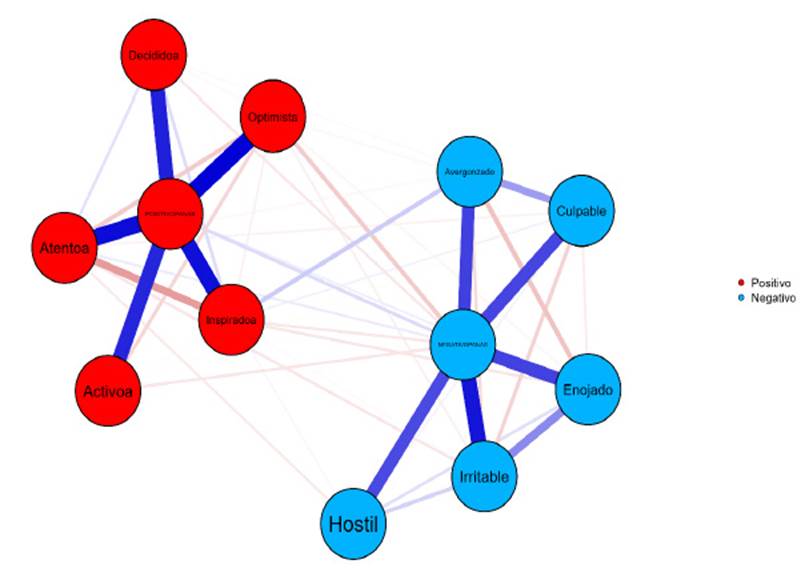
Source. Elaborated by the author.
Figure 4 Estimated network of abbreviated PANAS scale items and full version total score
Composite reliability and Cronbach's and Omega reliability coefficients for both constructs were above .70, which is considered adequate for research purposes (Furr & Bacharach, 2013) (see Table 4).
DISCUSSION
The purpose of this study was to develop a short version of the PANAS from the full version proposed by Watson et al. (1988a) that could be used in research and professional practice to assess affective states that are activators of both positive and negative emotional responses.
The PANAS is one of the most widely used tests to measure affective state (Medrano et al., 2015). The full 20-item version has been adapted in several countries and has been reported to have valid and reliable psychometric properties. Despite its rapid application, there is a need for short instruments, which is why short 10-item forms have been developed (Galinha et al., 2014; Gouveia et al., 2019; Kercher, 1992; Thompson, 2007).
Studies on the PANAS in Peru are scarce. The first study was on the full version, carried out in police officers, identifying a factorial structure of four dimensions, with problems in the reliability of the last dimension (Grimaldo, 2007). Regarding the short version, Gargurevich (2010) studied a 10-item version in university students and reported a two-dimensional scale, in addition to convergent and divergent validity indicators, as well as a Cronbach’s alpha reliability of .72 for both scales. This last aspect coincides with the results of this study’s purpose.
The full scale was applied to a sample of university students, the internal structure of the instrument was identified, and an exploratory graph analysis was performed on the 20 items; in this regard, Flores-Kanter et al. (2021) pointed out that graph analysis is a new and robust method for learning the latent structure underlying the scores of a scale. This procedure allowed the identification of two clearly established dimensions; one of positive affect and the other of negative affect, noting that the item alert was not part of either dimension. It was found that the items distressed, uneasy, frightened, nervous and fearful, reported communalities lower than 0.85, confirming the negative affect factor. On the other hand, the positive affect factor consisted of: determined, optimistic, inspired, active, and attentive.
Regarding the alert item, Ruiz-Pérez et al. (2021) point out problems in the scale, obtaining a very low and negative correlation, being perceived by subjects as a negative rather than a positive state, corresponding to the current context of health crisis; however, in studies prior to the pandemic by COVID-19, they did not report drawbacks in the item (Gargurevich, 2010; Thompson, 2007).
To determine the number of items, we eliminated those with the lowest factorial loads, such as strong, proud, interested, and enthusiastic, which correspond to positive affect, consistent with the study by Thompson (2007), who reported them as problematic items whose meanings were unclear, identified in a qualitative study with focus groups.
These processes were verified by confirmatory factor analysis, which validated the two factors with 10 items; PANAS + with the items: determined, optimistic, inspired, active, attentive, with lambda standardized coefficients between .69 and .85 and PANAS - with: irritable, hostile, angry, guilty, ashamed, with coefficients between .48 and .82. The structure of the short version reflects the same components of the full PANAS as proposed by Watson et al. (1988a). As for the underlying dimensions of the scale, the confirmatory analysis is consistent with the bifactor model of affectivity, showing appropriate fit indices.
The internal consistency reliability obtained ordinal Alpha and Omega coefficients for PANAS+ and PANAS- greater than 0.70, as reported by Ruiz-Pérez et al. (2021) and Gargurevich (2010). The correlation between the two subscales was -.24 (p < .01), similar to Thompson's (2007) and Watson et al.'s (1988a) original two-month test-retest reliability of the PANAS, suggesting that the 10-item PANAS compares well with the original 20-item PANAS in terms of reliability.
The reduced version has been found to be equivalent to the full 20-item version in terms of psychometric properties. As Flores-Kanter and Medrano (2018) point out, the advantage presented by this abbreviated version is that it allows for responses in extensive questionnaires with many variables or in applied settings with time constraints, such as in organizational or educational settings
Acknowledgments: The authors would like to thank the Universidad Nacional Federico Villarreal for their help
REFERENCES
Abarca-Castro, E. A., Villalobos, G., & Reyes, A. M. (2021). Implicaciones de la Psicoafectividad en el desarrollo humano. Revista Electrónica de Psicología Iztacala, 24(2). https://www.revistas.unam.mx/index.php/repi/article/view/79786 [ Links ]
Ato, M., López-García, J. J., & Benavente, A. (2013). Un sistema de clasificación de los diseños de investigación en psicología. Anales de Psicología / Annals of Psychology, 29(3), 1038-1059. doi: 10.6018/analesps.29.3.178511 [ Links ]
Ágoston, G., Péter, S., Ferenc, K. & Zsolt, D. (2011). Psychometric properties of the Hungarian version of the original and the short form of the positive and negative affect schedule (PANAS). Neuropsychopharmacologia Hungarica, 13(2), 73-79. [ Links ]
Ayala, A. & Cardona, M. (2016). Emociones y desempeño laboral. Revista Electrónica PSICONEX, 8(12), 1-9. https://revistas.udea.edu.co/index.php/Psyconex/article/view/326985 [ Links ]
Cabanac, M. (2002). What Is Emotion? Behavioural Processes, 60, 69-84. doi: 10.1016/S0376-6357(02)00078-5 [ Links ]
Cole, P. M., Martin, S. E., & Dennis, T. A. (2004). Emotion regulation as a scientific construct: Methodological challenges and directions for child development research. Child Development, 75(2), 317-333. doi: 10.1111/j.1467-8624.2004.00673.x [ Links ]
Colegio de Psicólogos del Perú (2017). Código de Ética y Deontología. https://www.cpsp.pe/documentos/marco_legal/codigo_de_etica_y_deontologia.pdf [ Links ]
Choliz, M. (2005). Psicología de la emoción: el proceso emocional. Universidad de Valencia. https://www.uv.es/choliz/Proceso%20emocional.pdf [ Links ]
Di Fabio, A., & Kenny, M. E. (2016). From Decent Work to Decent Lives: Positive Self and Relational Management (PS&RM) in the Twenty-First Century. Frontiers in Psychology, 7(361), 1-12. doi: 10.3389/fpsyg.2016.00361 [ Links ]
Dufey, M. & Fernández, A. M. (2012). Validez y confiabilidad del Positive Affect and Negative Affect Schedule (PANAS) en estudiantes universitarios chilenos. RIDEP, 34(1), 157-173. https://www.redalyc.org/pdf/4596/459645438008.pdf [ Links ]
Escobedo, M., Hernández, J., Estebané, V., & Martínez, G. (2016). Modelos de Ecuaciones Estructurales: Características, Fases, Construcción, Aplicación y Resultados. Revista Ciencia & Trabajo, 18(55), 16-22. [ Links ]
Ekman, P. (1992). An argument for basic emotions. Cognition & Emotion, 6(3-4), 169-200. doi: 10.1080/02699939208411068 [ Links ]
Flores-Kanter, P. E., & Medrano, L. A. (2018). Comparación de dos versiones reducidas de la Escala PANAS: análisis factoriales en una muestra argentina [Comparison of two short-forms of the PANAS: Factor analysis in a Argentine sample]. Revista Iberoamericana de Diagnóstico y Evaluación Psicológica, 49(4), 37-46. doi: 10.21865/RIDEP49.4.03 [ Links ]
Flores‐Kanter, P. E., Garrido, L. E., Moretti, L. S., & Medrano, L. A. (2021). A modern network approach to revisiting the Positive and Negative Affective Schedule (PANAS) construct validity. Journal of Clinical Psychology, 77, 2370-2404. doi: 10.1002/jclp.23191 [ Links ]
Furr, R. M., & Bacharach, V. R. (2013). Psychometrics: An introduction (2nd ed.). Sage. [ Links ]
Galinha, I. C., Pereira, C. R & Esteves, F. (2014). Versão reduzida da escala portuguesa de afeto positivo e negativo - PANAS-VRP: Análise fatorial confirmatória e invariância temporal. Psicología, 28(1), 53-65. [ Links ]
García, F. E., & Arias, P.R. (2019). Propiedades psicométricas de la Escala de afecto positivo y negativo en población ecuatoriana. Revista Mexicana de Psicología, 36(1), 55-62. [ Links ]
Gargurevich, R. (2010). Propiedades psicométricas de la versión internacional de la Escala de Afecto Positivo y Negativo-forma corta (I- Spanas SF) en estudiantes universitarios. Persona, (13), 31-42. doi: 10.26439/persona2010.n013.263 [ Links ]
Gargurevich, R., & Matos, L. (2012). Validez y confiabilidad de la Escala de Afecto Positivo y Negativo (SPANAS) en estudiantes universitarios peruanos. Revista de Psicología (Trujillo), 14(12), 208-217. [ Links ]
Gómez, C. & Leyton, J. (2020). Evidencia de los procesos psicométricos de la Escala de Afecto Positivo y Negativo (SPANAS) en estudiantes universitarios de universidades privadas de la ciudad de Piura [Tesis de Licenciatura en Psicología, Universidad César Vallejo, Piura, Perú]. https://hdl.handle.net/20.500.12692/53946 [ Links ]
Gouveia, V. V., Ribeiro, M. G. C., Loureto, G. D. L., Neta, O. F. S., Neta, O. F. S., Gouveia, R. S. V., Vilar, R., & Freire, S. E. A. (2019). Scale of Positive and Negative Affects (EAPN-10): evidence of its psychometric adequacy. Temas em Psicologia, 27(1), 189-203. doi: 10.9788/TP2019.1-14 [ Links ]
Gray, E. K., & Watson, D. (2007). Assessing positive and negative affect via self-report. In J. A. Coan & J. J. B. Allen (Eds.), Handbook of emotion elicitation and assessment (pp. 171-184). Oxford University Press. [ Links ]
Grimaldo, M. (2003). Validez y confiabilidad de la Escala de Afectos Positivos y Negativos (SPANAS) en estudiantes de secundaria de nivel socioeconómico medio y bajo. Cultura, 17, 341-364 [ Links ]
Grimaldo, M. (2007). Propiedades psicométricas de la Escala de afectos positivos y negativos (PANAS-X). Nuevos Paradigmas, 33-50. [ Links ]
Joiner, T. E., Sandin, B., Chorot, P., Lostao, L. & Marquina, G. (1997). Development and factor analytic validation of the SPANAS among women in Spain: (More) cross-cultural convergence in the structure of mood. Journal of Personality Assessment, 68(3), 600-615. doi: 10.1207/s15327752jpa6803_8 [ Links ]
Karim, J., Weisz, R., & Rehman, S. U. (2011). International positive and negative affect schedule short-form (I-PANAS-SF): Testing for factorial invariance across cultures. Procedia - Social and Behavioral Sciences, 15, 2016-2022. doi: 10.1016/j.sbspro.2011.04.046 [ Links ]
Keltner, D. & Gross, JJ (1999). Cuentas funcionales de las emociones. Cognición y emoción, 13(5), 467-480. [ Links ]
Kercher, K. (1992). Assessing Subjective Well-Being in the Old-Old: The PANAS as a Measure of Orthogonal Dimensions of Positive and Negative Affect. Research on Aging, 14(2), 131-168. doi: 10.1177/0164027592142001 [ Links ]
Leue, A., & Beauducel, A. (2011). The PANAS structure revisited: On the validity of a bifactor model in community and forensic samples. Psychological Assessment, 23(1), 215-225. doi: 10.1037/a0021400 [ Links ]
Lemos, M. (2020). Los modelos dimensionales de la personalidad y su importancia en la psicología de la salud. Revista de Psicología Universidad de Antioquia, 12(2), e342593. doi: 10.17533/udea.rp.e342593 [ Links ]
López, A. F., Rondón, J. M., Alfano, S. M., & Cellerino, C. (2012). Relaciones entre esquemas tempranos inadaptados y afectividad positiva y negativa. Ciencias Psicológicas, 6(2), 149-173. doi: 10.22235/cp.v6i1.73 [ Links ]
Medrano, L. A., Flores, P. E., Trógolo, M., Curarello, A., &. Gonzales, J. (2015). Adaptación de la Escala de Afecto Positivo y Negativo (PANAS) para la población de Estudiantes Universitarios de Córdoba. Anuario de Investigaciones de la Facultad de Psicología, 2(1), 22-36. https://revistas.unc.edu.ar/index.php/aifp/article/download/12503/12773 [ Links ]
Morán-Pallero, N. & Felipe-Castaño, E. (2021). Autoconcepto en las redes sociales y su relación con el afecto en adolescentes. Behavioral Psychology / Psicología Conductual, 29(3), 611-625. doi: 10.51668/bp.8321306s [ Links ]
Moreta-Herrera, R., Perdomo-Pérez, M., Reyes-Valenzuela, C., Torres-Salazar, C., & Ramírez-Iglesias, G. (2021). Invarianza factorial y fiabilidad de la escala de afecto positivo y negativo (PANAS) en una muestra de universitarios de Colombia y Ecuador [Factor invariance and reliability of Positive and Negative Affect Schedules (PANAS) in university students in Colombia and Ecuador]. Anuario de Psicología, 51(2), 76-85. [ Links ]
Moriondo, M., De Palma, P., Medrano, L. A. & Murillo, P. (2012). Adaptación de la Escala de Afectividad Positiva y Negativa (PANAS) a la población de adultos de la ciudad de Córdoba: análisis psicométricos preliminares. Universitas Psychologica, 11(1), 187-196. [ Links ]
Niedenthal, P. M. & Ric, F. (2017). Psychology of emotion (2nd ed.). Routledge. [ Links ]
Ovejero, M., & Velázquez, M. (2017). La predisposición al afecto positivo y su relación con el bienestar: un estudio ex post facto prospectivo en población española. Revista Mexicana de Investigación en Psicología, 9(1), 15-30. https://www.revistamexicanadeinvestigacionenpsicologia.com/index.php/RMIP/article/view/225 [ Links ]
Peker, M., Meşe, G., & Cem, N. (2021). Psychometric evaluation of the implicit positive and negative affect test in Turkish samples. Turkish Journal of Psychiatry, 32(1), 43-50. doi: 10.5080/u23558 [ Links ]
Piqueras, J. A., Ramos L., V., Martínez G., A. E. & Oblitas G., L. A. (2009). Emociones negativas y su impacto en la salud mental y física. Suma Psicológica, 16(2), 85-112. http://www.redalyc.org/articulo.oa?id=134213131007 [ Links ]
Pires, P., Filgueiras, A., Ribas, R. & Santana, C. (2013). Positive and negative affect schedule: psychometric properties for the Brazilian Portuguese version. Spanish Journal of Psychology, 16(58). doi: 10.1017/sjp.2013.60 [ Links ]
Reeve, J. (2010). Motivación y emoción (5a ed.). McGraw-Hill. [ Links ]
Riopel, L. (2019). What is the Positive and Negative Affect Schedule? (PANAS). https://positivepsychology.com/positive-and-negative-affect-schedule-panas/ [ Links ]
Robles, R. & Páez, F. (2003). Estudio sobre la traducción al español y las propiedades psicométricas de las escalas de afecto positivo y negativo (PANAS). Salud Mental, 26(1), 69-75. https://www.redalyc.org/articulo.oa?id=58212608 [ Links ]
Rogaten, J., & Moneta, G. B. (2015). Use of creative cognition and positive affect in studying: Evidence of a reciprocal relationship. Creativity Research Journal, 27(2), 225-231. doi: 10.1080/10400419.2015.1030312 [ Links ]
Ruiz-Pérez, J. I., Melo-González, V., Velandia-Amaya, S. N., Rodríguez-Mesa, L. E., & Velázquez, C. A. (2021). PANAS Internacional Revisado: Propiedades psicométricas en una muestra internacional latina. Universitas Psychologica, 19, 1-11. doi: 10.11144/Javeriana.upsy19.pirp [ Links ]
Thompson, E. R. (2007). Development and validation of an internationally reliable short-form of the positive and negative affect schedule (PANAS). Journal of Cross-Cultural Psychology, 38(2), 227-242. [ Links ]
Torres-Salazar, C., Moreta-Herrera, R., Ramos-Ramírez, M., & López-Castro, J. (2020). Optimismo como rasgo y sesgo cognitivo en el Bienestar Subjetivo y Psicológico de estudiantes ecuatorianos. Revista Colombiana de Psicología, 29(1), 61-72. doi: 10.15446/.v29n1.75853 [ Links ]
VandenBos, G. R. (Ed.). (2015). APA Dictionary of Psychology (2nd ed.). American Psychological Association. http://www.jstor.org/stable/j.ctv1chrw2d.1 [ Links ]
Watson, D., & Clark, L. A. (1992). Affects separable and inseparable: On the hierarchical arrangement of the negative effects. Journal of Personality and Social Psychology, 62(3), 489-505. doi: 10.1037/0022-3514.62.3.489 [ Links ]
Watson, D., & Clark, L. A. (1984). Negative affectivity: The disposition to experience aversive emotional states. Psychological Bulletin, 96(3), 465-490. doi: 10.1037/0033-2909.96.3.465 [ Links ]
Watson, D., Clark, L. A., & Tellegen, A. (1988a). Development and validation of brief measures of positive and negative affect: The PANAS scales. Journal of Personality and Social Psychology, 54(6), 1063-1070. doi: 10.1037/0022-3514.54.6.1063 [ Links ]
Watson, D., Clark, L. A., & Carey, G. (1988b). Positive and negative affectivity and their relation to anxiety and depressive disorders. Journal of Abnormal Psychology, 97(3), 346-353. doi: 10.1037/0021-843x.97.3.346 [ Links ]
Watson, D., Clark, L. & Stasik, S. (2011). Emotions and the Emotional Disorders: A Quantitative Hierarchical Perspective. International Journal of Clinical and Health Psychology, 11(3), 429-442. [ Links ]
Zubiría, M. (2013). La afectividad humana. https://anmdecolombia.org.co/wp-content/uploads/2013/08/Vida-Afectiva.pdf [ Links ]
Received: February 11, 2023; Revised: March 20, 2023; Accepted: April 14, 2023; pub: April 20, 2023











 text in
text in 


